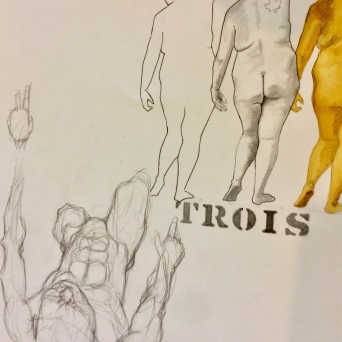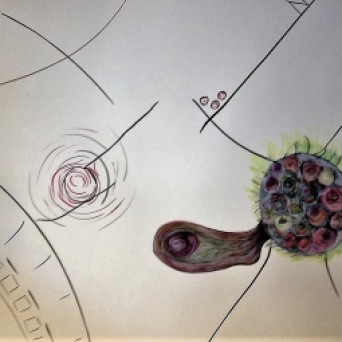Author: daphne
6th State
5th State
Our artists have added more layers to each of our six canvases – here are the results:
“A Lullaby” Sleep, my daughter, sleep, and when you wake to everything that’s quick and breathes in every part of you, dream, my daughter, dream. – Gary Gildner Limberlost Press 1995

“Ask Me” You and I can turn and look at the silent river and wait. We know the current is there, hidden, and there are comings and goings from miles away that hold the stillness exactly before us. What the river says, that is what I say. – William Stafford (excerpt) You Must Revise Your Life 1989

“Refuge” I see the lamp, the face, the eye, an altar where the soul bows, a gladness and refuge. My loving says, “Here. I can leave my personality here.” My reason agrees! “How can I object when a rose makes the bent backs stand up like cypresses?” The Soul of Rumi (excerpt) – trans. C. Barks 2001
4th State, Collaboration Project
“The trick is to do what you love and to be content alone in the studio. And if you that, you have everything you need.” Thomas Nozkowski, Painter
The images are getting richer and more intense. Some are even leaning into story-telling. Responding to an active canvas is certainly different than facing a blank one! Although we each work alone in a studio, our collaborators’ spirits join us on the page as we apply color and line with brush, pencil, pen. Here are our artists’ responses:
Collaboration Project, 3rd State
“Collaboration in art is the ultimate test of placing your ego aside in order to work toward a common idea. Artists often mention how creating art is like a dialogue – a conversation between the artist and the work… For this reason alone, mutual respect between art collaborators is very important…” Brian Sherwin, Fine Arts Review
As for the six artists in the editionvariable group, we are looking for the surprises these efforts will produce. We have reached the “third state” in our year-long collaboration, and adding our own interpretations to the images has been challenging and fun.
Moku Hanga – Japanese Woodblock Printmaking
Moku hanga is a traditional Japanese form of woodblock printmaking notable for black outlines, vibrant colors, and angled perspectives (think of Hokusai and Hirosada). In modern times the images may have changed, but the process remains much the same, and its simplicity is very appealing, requiring not much more than a block of wood, a cutting tool (gouge), ink, and paper. The image, a type of relief print, is produced by carving away everything except the lines to be printed. To make a print, the block’s surface is saturated with water color and nori paste, and then slightly dampened paper is laid down and pressed with a buren. For multiple colors, multiple blocks are carved, with exact registration (kento) marks on each block. As the images are all hand-pulled, moku hanga prints don’t need a press, and using water-based inks makes this for an easy clean-up. McClains Printmaking Supplies is a good source for tools, blocks, and books about the process.
Carving can take a long time, but it’s an opportunity for contemplation, for “being in the moment” with your image, and the blocks eventually become works of art, along with the prints. San Francisco-based Bay Area Rapid Transit (BART) selected Berkeley artist Miwako Nishizawa, born in Kyoto Japan, to create pieces for its 2016 poster art series using the moku hanga woodblock technique.
Here are my first prints using this process. The first, “Breakfast Bee?” (the nuthatch and the bee), is in the Wingtip Press 2019 Leftovers print exchange. The other prints are entitled “Leafy Lullabies” (the crow is listening to, and looking for bugs under the leaves), and “Chrysanthemum” (inspired by a Hirosado print and an image of my niece).
Collaboration Project, 2nd State
We are all familiar with successful collaborations. With this in mind, the editionvariable group has begun a year-long collaboration, and during this past month, our artists have exercised their imaginations, resulting in a 2nd state for these six works:
Collaboration Project
We are all familiar with artists whose collaborations have sparked synergy in their work. Our Edition Variable group plans a collaboration in which each of our six artists creates an image on 22″ x 30″ paper using any media. Each month these pages are exchanged and transformed using line, color, collage, stitchery, erasure, etc., so that after a year, each artist will have visited each page twice. Like the wardrobe door into Narnia, or Alice’s rabbit hole, these pages will invite our artists into a magical place.
Here are some close-ups of our beginning images. Stay tuned for our monthly transformations!
What motivates us?
Waves, patterns, blues and grays, wind and sea: the immediacy of nature is compelling. What could ever match the enthusiasm of a run on the beach at sunset? What motivates us to do art, to want to be enveloped by it? Two recent art shows can help us to think about that.
At Things You Know but Cannot Explain, Rick Bartow’s show at the Jordan Schnitzer Museum of Art, his animal/man archetypes confront you in vivid color, in grand gesture, and with human eyes that make the space between you and each painting feel electric. These paintings reveal the inner self and harness the power of lucid dreams. My favorites include Minotaur 3, Fishmother, and Little Hawk’s Spirit. Of his wood sculptures, I love the salmon with fin-hands and Man Acting Like Dog. This exhibit will travel for three years, but you can see Bartow ‘s work at the Froelick Gallery.
The Portland Art Museum exhibit, Fotofolio – Adams, Strand, Weston, Weston, White – delves into how these artists chose images for portfolios. Ansel Adams’ photographs are “ends in themselves, images of the endless moments of the world.” Minor White’s sequences evoke emotion and a “better understanding.” Paul Strand included “the spirit of his subjects in the very body of the photo.” Edward Weston felt art was “a living thing which depends upon full participation.” Both he and son Brett pursued closeups of nature in the abstract – Brett called them “elegant bits.” Of all these, my favorites were Strand’s images of the lives of ordinary Mexicans, perhaps because they each tell a story (and are very fine photogravures). Here one might ask, “Do my images have a unifying theme, and what kind of story might they tell?”
Go Gomuban!
My preferred etching substrate is copper, but I was willing give Gomuban relief printing plates a go (thanks, Deb!). The challenge was to design an image featuring water creatures. I found that the plate was soft and easy to carve. After applying burnt umber Akua ink, I used a baren to pull the prints by hand. If my imaginary fish looks friendly, my work here is done.



























































